
Tremont, Tennessee
Encyclopedia
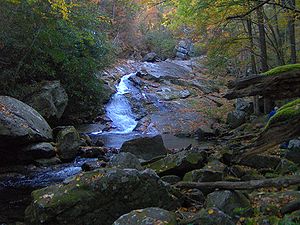
Great Smoky Mountains National Park
Great Smoky Mountains National Park is a United States National Park and UNESCO World Heritage Site that straddles the ridgeline of the Great Smoky Mountains, part of the Blue Ridge Mountains, which are a division of the larger Appalachian Mountain chain. The border between Tennessee and North...
, located in the southeastern United States. Formerly home to a pioneer Appalachia
Appalachia
Appalachia is a term used to describe a cultural region in the eastern United States that stretches from the Southern Tier of New York state to northern Alabama, Mississippi, and Georgia. While the Appalachian Mountains stretch from Belle Isle in Canada to Cheaha Mountain in the U.S...
n community and logging town, Tremont is now the location of the Great Smoky Mountains Institute at Tremont.
Geography
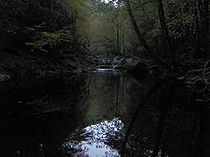
Townsend, Tennessee
Townsend is a city in Blount County, Tennessee, in the southeastern United States. The population was 244 at the 2000 census. Townsend is one of three "gateways" to the Great Smoky Mountains National Park and the home of several museums and attractions relating to both the natural and human...
in Blount County, Tennessee
Blount County, Tennessee
Blount County is a U.S. county located in the U.S. state of Tennessee. Its population was 123,010 at the United States Census, 2010. The county seat is at Maryville, which is also the county's largest city....
. "Tremont" can refer to the former logging town of Tremont or the Great Smoky Mountains Institute at Tremont, but it generally applies to Middle Prong's entire watershed between Miry Ridge to the east and Defeat Ridge to the west. Both of these ridges run perpendicular to the main crest of the Great Smokies, which rises several thousand feet above Tremont to the south.
Middle Prong is formed by the confluence of Lynn Camp Prong, which flows down from the southeast, and Thunderhead Prong, which flows down from the southwest. From this junction, Middle Prong flows north for another 6 miles (9.7 km) to its mouth along Little River at an area known as the Townsend Y. About halfway between the Lynn Camp-Thunderhead junction and the Y, a narrow bottomland known as Walker Valley has been cut as Middle Prong absorbs several small streams flowing down from Meigs Mountain
Meigs Mountain Trail
The Meigs Mountain Trail is an American hiking trail in the Great Smoky Mountains National Park of Sevier County, Tennessee. The trail traverses the northern slopes of Meigs Mountain in the northwest section of the park, connecting Jakes Creek in the Elkmont area with Lumber Ridge in the Tremont area...
and Fodderstack Mountain. The Great Smoky Mountains Institute at Tremont is located in Walker Valley.
Tremont Road runs parallel to Middle Prong, and is paved from its intersection along Little River Road to the Institute at Walker Valley. A gravel road extends for another three miles (5 km) to a cul-de-sac and parking area at the Lynn Camp-Thunderhead junction. Along Little River Road, Cades Cove
Cades Cove
Cades Cove is an isolated valley located in the Tennessee section of Great Smoky Mountains National Park, USA. The valley was home to numerous settlers before the formation of the national park...
is approximately 7 miles (11.3 km) to the west and Elkmont
Elkmont, Tennessee
Elkmont is a region situated in the upper Little River Valley of the Great Smoky Mountains of Sevier County, in the U.S. state of Tennessee. Throughout its history, the valley has been home to a pioneer Appalachian community, a logging town, and a resort community...
is 13 miles (20.9 km) to the east.
Early settlement
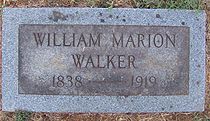
Even in his own time, Walker was something of a legend. His sharpshooting skills were so well-known, he was often barred from shooting contests. Walker kept over a hundred bee stands, which he robbed without the use of mask or smoke, and sold the honey in nearby Tuckaleechee. During the U.S. Civil War, he aided struggling families in Tuckaleechee by going from house to house to cut firewood and do basic chores.
While Walker was well liked and respected throughout the northwestern Smokies, he was always a source of controversy due to his practice of polygamy
Polygamy
Polygamy is a marriage which includes more than two partners...
. Walker, who was very religious, believed that Biblical scripture allowed him to take more than one wife. In 1864, he married Mary Ann Moore and a few years later married a third wife, Mary Moll Stinnett. Walker eventually fathered a total of 26 children, although several died in infancy. He allowed tenant farmers to move into Walker Valley, and a small community developed. Walker constructed three gristmill
Gristmill
The terms gristmill or grist mill can refer either to a building in which grain is ground into flour, or to the grinding mechanism itself.- Early history :...
s to accommodate the growing community.
Early logging
As large-scale logging operations left much of the Eastern United States deforested by the late 19th century, logging companies turned to the remote virgin forests of Southern Appalachia to meet the nation's growing demand for timber. Taking advantage of recent band sawBand saw
A bandsaw is a power tool which uses a blade consisting of a continuous band of metal with teeth along one edge to cut various workpieces. The band usually rides on two wheels rotating in the same plane, although some small bandsaws have three wheels. Bandsawing produces uniform cutting action as a...
and logging railroad innovations, small logging firms began to spring up around the Great Smokies.
The first logging venture to reach Walker Valley and the Middle Prong area was that of John English, a Knoxville businessman whose company began cutting timber in nearby Tuckaleechee Cove in the early 1880s. English used a series of splash dams to move the logs down Little River to a mill on the outskirts of Knoxville. One such splash dam was located at the mouth of Spruce Flats along Middle Prong, just above Walker Valley. While English's lumbering venture turned a small profit, a flood along Little River apparently wiped out his splash dams in the late 1890s, and his venture had folded by 1900.
The Little River Lumber Company

Townsend set up a band saw mill in Tuckaleechee, and the town that bears his name grew up in the vicinity. He formed the Little River Railroad to connect the mill with the Southern Railroad terminal at nearby Walland
Walland, Tennessee
Walland is an unincorporated community in Blount County, Tennessee, in the Southeastern United States. Walland is the site of a post office and is the place name associated with zip code 37886, which covers an area beyond the Walland community...
, and with able engineers managed to lay railroad tracts all the way to the upper reaches of Little River and Jakes Creek.
In 1918, Walker suffered a stroke that left him largely incapacitated. On December 26 of that year, he finally agreed to sell Middle Prong to Little River Lumber after Townsend gave him his word that he wouldn't harvest trees along Thunderhead Prong. Six months later, Walker died after suffering a second stroke. On Townsend's orders, a small train carried Walker's coffin ceremoniously to the Bethel Baptist Cemetery in Tuckaleechee, where it rests today.
Tremont

While Tremont remained a base of operations, the logging camps moved further and further up Lynn Camp Prong as the operation progressed. These camps consisted of small shanty houses that could be loaded onto flatcars and moved from camp to camp. The base camp at Tremont consisted of a post office, hotel, maintenance sheds, a general store, and a community center that served as a church, school, and movie theater.
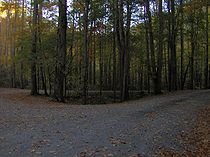
...sometimes without warning, a heavy thunderstorm high on the mountain changed it into a roaring, tearing monster. At night, after a storm, we could hear the giant rocks being pushed and crushed together by its force. Trees, loosened by the flood, crashed into the water to be swept downstream.
As with Elkmont to the east, Townsend sought to promote the Tremont area as a summer resort. The Tremont Hotel opened in 1926 to provide housing for loggers and transients, but as the camps moved further up the valley, the hotel was opened up to tourists. The hotels at both Elkmont and Tremont developed a reputation as licentious places among the mountain people, as Cope recalled:
The rumors and stories of what went on in the hotels kept the natives entertained. Some thought of them as the Sodom and Gomorrah of the mountains. A few local girls were employed as maids at both hotels. Pretty, young daughters were warned to stay away from the places.
Townsend had promised Will Walker that Thunderhead Prong would not be cut, a promise he kept until his death in 1935. With Townsend out of the way, however, the Little River Lumber Company proceeded to harvest Thunderhead Prong. In December 1938, the last trees were cut in the Tremont area.
The National Park
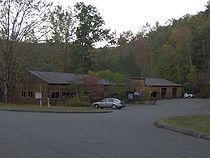
Great Smoky Mountains National Park
Great Smoky Mountains National Park is a United States National Park and UNESCO World Heritage Site that straddles the ridgeline of the Great Smoky Mountains, part of the Blue Ridge Mountains, which are a division of the larger Appalachian Mountain chain. The border between Tennessee and North...
in 1934 and the end of logging operations in 1938, however, the forest quickly regrew. The Civilian Conservation Corps
Civilian Conservation Corps
The Civilian Conservation Corps was a public work relief program that operated from 1933 to 1942 in the United States for unemployed, unmarried men from relief families, ages 18–25. A part of the New Deal of President Franklin D...
converted Little River Railroad's railroad beds into roads and trails. Today, other than the occasional stray skidder
Skidder
A skidder is any type of heavy vehicle used in a logging operation for pulling cut trees out of a forest in a process called "skidding", in which the logs are transported from the cutting site to a landing. Here they are loaded onto trucks , and sent to the mill...
cable or railroad tie, there is little immediate evidence that logging ever took place in the area.
In 1969, Maryville College
Maryville College
Maryville College is a private four-year liberal arts college in Maryville, Tennessee, near Knoxville. It was founded in 1819 by Presbyterian minister Isaac L. Anderson for the purpose of furthering education and enlightenment into the West. The College is one of the fifty oldest colleges in the...
, with the help of the National Park Service, established the Tremont Environmental Education Center at the site of a former Job Corps
Job Corps
Job Corps is a program administered by the United States Department of Labor that offers free-of-charge education and vocational training to youth ages 16 to 24.-Mission and purpose:...
center in Walker Valley. The purpose of the center was to provide a first-hand approach to understanding the environment and ecology of the mountains. In the early 1970s, the center hosted the Youth Conservation Corps
Youth Conservation Corps
The Youth Conservation Corps ' is a summer work youth program in federally managed lands. The National Park Service, US Forest Service, US Fish and Wildlife Service and Bureau of Land Management employ teens each summer to participate in the YCC experience...
during the summer. In 1980, the Great Smoky Mountains Natural History Association assumed control of the education center, and in 1985 the name was changed to the Great Smoky Mountains Institute at Tremont to further acknowledge its ties to the park.

